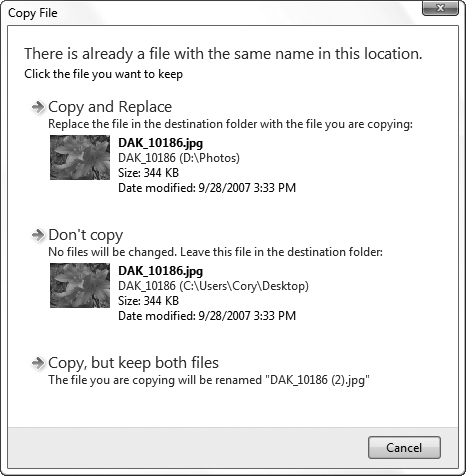What is Windows Explorer if
not a file manager at heart? Sure, the Start menu is a home-base of
sorts, but the desktop and your folders are basically there to store
your stuff. When it comes to copying, moving, renaming, deleting, and
opening files, Explorer is where it's at.
1. Why It Takes So Long to Copy Files
Most
people first realize that something is wrong with Vista when they try
to copy or move files, and they see the little green progress window
shown in Figure 1.
It'd be understandable to see this window on screen for a minute or two
if you're copying a lot of data, but should it really take three full
minutes to move one small file, or eight minutes to delete another?

This is one of two "Green Ribbons of Death" in Windows Vista, the other being the larger progress bar— that appears at the top of the Windows Explorer window in the address bar/path box. So, what's going on?
It
turns out that several things can cause Windows Explorer to take a long
time copying, moving, or deleting files, and some of them are actually
legitimate.
First, Windows Explorer takes time to
examine the files and folders you're copying, moving, etc., and
checks—ahead of time—to see whether there are any conflicts, such as
existing files in the destination folder or security issues that need
your attention. That's why you'll see Vista's nifty confirmation window (Figure 2) just once for 34 conflicts, rather than the 34 individual confirmations you'd have to endure in earlier versions of Windows.

The confirmation window in Figure 2
is actually quite nice because of all the choices you get. If you're
copying media files (e.g., photos, videos, PDF documents), you'll see
thumbnail previews to aid your decision; you can even right-click the
thumbnails directly in this window if you want to work with the files
without interrupting the file operation. What's more, you can choose to
copy or move the file without replacing the original, renaming it instead to avoid the conflict. |
|
The
downside is that Explorer must delay your file operation while it
prepares the confirmation window; depending on what it encounters along
the way, this can take forever.
One
of the main reasons for the delay is a side effect of User Account
Control, the same security "feature" that turns the screen black for an
moment before asking your permission to make a change to your system.
Naturally, Vista has to examine each file you're copying to make sure
you have permission to copy it, and then examine the destination to make
sure you have permission to put the file there.
Likewise,
if you're copying files over a network, Windows has to do some security
reconnaissance, and depending on the speed of your network connection,
this can take even longer.
But security checks
alone aren't responsible for Vista's abysmal performance in this area;
there's also the matter of thumbnails.
2. Slicker Ways to Select Files
Why
drag 17 files individually when you can select and drag them all at
once? For one, it's tremendously aggravating to select the first 16
files, and then lose the selection with an errant click in the wrong
place.
Selecting
files is an art form, or at least it would be in a much more boring
world than ours. Here are some slick ways to select multiple files in
Windows Explorer:
Rubber bands
Need to select a cluster of
files? Click in an empty area near the first file and then draw a box
around the others to select them all in a single swoop, as shown in Figure 3.

Keyboard and mouse
You can hold the Ctrl key to select files one-by-one, or hold the Shift key to select a range of files. Just be careful not to drag the files while holding Ctrl, lest you inadvertently create copies of them all.
Keyboard alone
While holding the Ctrl
key, move through a list of files with the up and down arrow keys. When
the dotted rectangle surrounds a file you want, press the Space bar to select it.
Or, to select a range of files, use the arrow keys to find the first file; then, hold Shift while you expand the selection with the arrow keys. Thereafter, you can even use the Ctrl key to select and deselect individual items.
Filespec
In the Search box in the top-right of the Explorer window, type a filespec—a
pattern you choose—to filter the list and show only the matching files.
Filespecs typically contain ordinary characters (letters and numbers)
along with wildcards, like the question mark (?) and the asterisk (*), which represent any single character or any number of characters, respectively.
For instance, type *.txt to show only files with the .txt filename extension, or v??.* to show files of any type that start with v and have only three letters in the filename.
In a moment or two, Windows Explorer will show only the files that match your filespec, at which point you can press Ctrl-A
to select them all. Most of the time, this is a whole lot faster—not to
mention more accurate—than trying to select the files by hand.
Checkboxes
You like clicking checkboxes? In Windows Explorer, click the Organize drop-down, select Folder and Search Options, and then turn on the Use check boxes to select items option. Click OK, and your folder now looks like Figure 4;
then, click the checkbox next to any file to select it without holding
down any keys or worrying about clicking in the wrong place.
